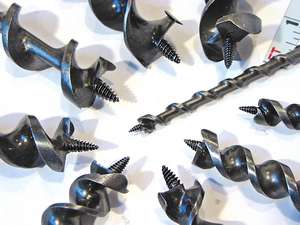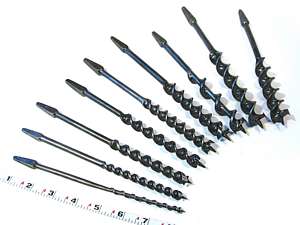AUGERS FOR WOOD
What we all think of as "drill bits" are for metal. The big ones especially (getting up toward 1/2") can only chew up and split wood. It is pointless to argue over changing the standard 118 deg tip angle to "blunter (130 deg) for harder materials and sharper (60-90 deg) for softer or gummy materials" (as if any of us had the facilities to do this), because the problem is not penetration of the material. The problem is lack of incising cutters to sever the wood fibers cleanly. You must make a cleanly cut circumference for your hole before you dig out the central material. No metal machine shop drill bit can do this.
For woodworking, the next step up is a "brad point drill", and better still is a Forstner bit drill (just search on those terms in your favorite shopping engine from Amazon, Google catalogs, whatever. (Every source offers Forstner, but Amazon hasn't heard of brad point drills yet.)
Augers are as good as Forstners, and I think you'll like the price too. In this country, the Forstner bits are impossible to sharpen because the outer circumference-slicing circle part can not be removed from the inner propeller-like knives, which are straight. There is no way to sharpen both a circular and a straight surface at the same time. So, buy a tungsten carbide set and throw them out like everybody else, but at least not as often as plain steel. Duck into a hardware store the next time you're in Germany.
AUGER ADVANTAGES
- Clean holes, even if large
- Flat-bottom hole -- add
a washer, make a recessed bolt or screw. If deep enough, can be
plugged with wooden cover.
- Slanted, flat-bottomed hole ("pocket hole"). Classic way to anchor table top to skirts.
- Very deep holes -- through floor joists for putting Cat5 LAN cabling into a house.
click on photo to enlarge
The 9 augers above date from the 1920s to 1930s. They are in good condition, but were not in my personal use and need some sharpening (see below). They are 7" - 9" long (no stubbies). Augers follow a convention of stamping the hole diameter in 16ths onto one face of the tang. Here are the sizes & mfrs:
- 4/16"
Irwin
- 6/16" Russell Jennings
- 8/16" Keen Kutter
- 9/16" M&M Co. Phila, Pa
- 10/16" Mathieson
- 12/16" Russell Jennings
- 13/16" Irwin
- 14/16" M&M Co.
- 15/16" Biddle Hdw Co
OTHER AUGER PHOTOS
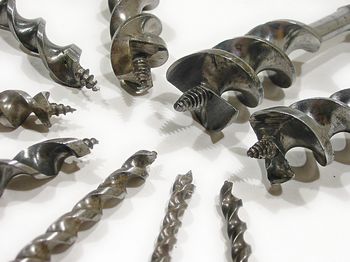
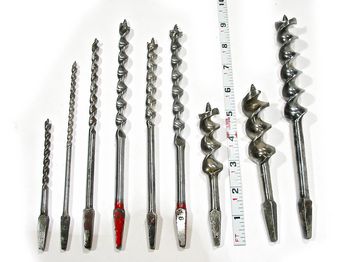
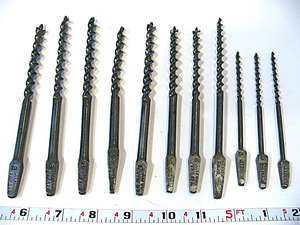
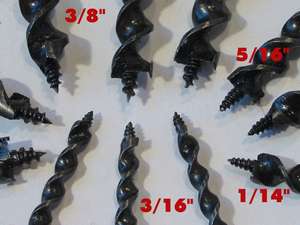
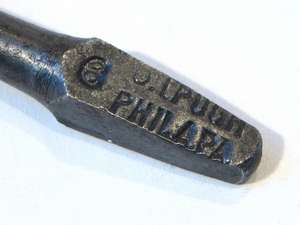
SHARPENING AUGERS -- need photo of files, photo of modern expansion bit, photos of brad point and Fostner bits
The circle-incising auger cusps can be touched up with almost anything, but to file the straight wood-slicing knives without damaging the thread at the tip of the bit, you need a Nicholson 7" Auger Bit file. These are getting hard to find. Try toolsforworkingwood.com
or this site.
Buy a couple files. Sears Craftsman made one too, also 7" long, but it weighs half as much and doesn't have as much meat on the bone. Since it is both narrower and made of thinner stock, all filing areas are smaller. The entire tool will wear out faster.
EXPANSION BITS
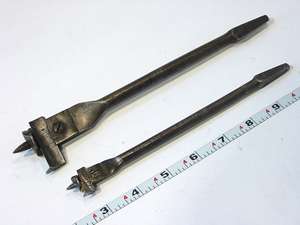
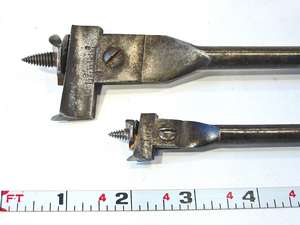
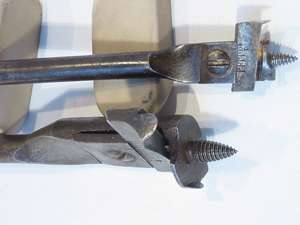

--------------------------------------------------------------------------------------------------------------------
